Polar Encyclopædia
THE SOLAR ENERGY BALANCE
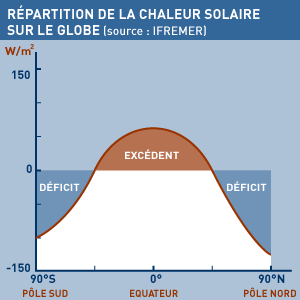
OUR EARTH’S HEATING SYSTEM: THE SUN
Our planet has an excellent source of energy: Sun. When solar radiation (i.e. the Sun’s rays) reaches the Earth’s atmosphere, part of it is reflected back outwards and part of it is absorbed by the atmosphere. The rest reaches the Earth’s surface, where once again, part is reflected back and part is absorbed. The atmosphere and the surface (both land and ocean) are heated, and thus emit infrared radiation out towards space. The overall difference between incoming and outgoing energy is known as the net radiation or radiation balance, and it can be stated for a region or for the planet as a whole.
HOT IN THE TROPICS, COLD AT THE POLES
The Sun does not heat all parts of the Earth to the same extent; the Equator receives more energy than the poles. This is because the Earth is round and spins leaning over in relation to the Sun. So at the poles, the Sun’s rays hit the Earth at a very flat angle and they also have to pass through more of the atmosphere so more of their energy is absorbed. Lastly, the heat input is shared over a larger surface.
TWO COLD POLES
In winter, the nights in the polar regions are very long. Without the Sun’s heat, it is very cold. Furthermore, the Earth continues to emit infrared radiation outwards so it continues to lose heat. In summer, the white snow and ice act as a giant mirror, reflecting back the Sun’s rays and absorbing very little (the albedo effect). Over a year, the polar regions lose more energy than they receive.
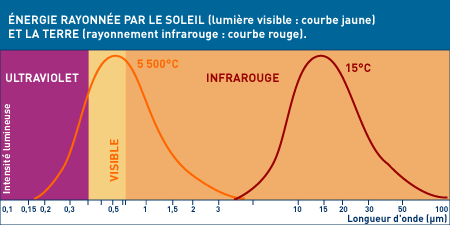
HEAT EXCHANGES AROUND THE GLOBE
In theory, the polar regions should keep getting colder and the tropics hotter, but a lot of the excess heat received by tropical zones is absorbed by the oceans and the atmosphere, so the ocean currents and winds transport it to cooler regions, helping to establish an overall balance. However, the Earth’s overall radiation balance (or net radiation) can be positive, which means the planet is warming up, or negative, which means it is getting colder.
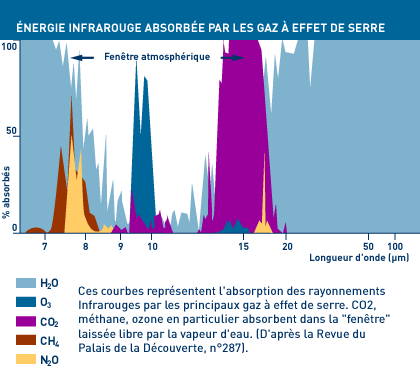
VISIBLE (LIGHT) AND INVISIBLE (INFRARED) RADIATION
Most of the radiation emitted by the Sun is short-wave (<4µm) electromagnetic radiation, which includes visible light. Part of this energy is re-emitted back outwards by the Earth in the form of long-wave (>4µm) electromagnetic radiation, known as infrared or heat radiation. The Earth, like our bodies when they are hot, radiates heat outwards.
Currently, the total energy received from the Sun, as measured at the edge of the Earth’s atmosphere several dozen kilometres up, is on average 340 Watts per square metre (W/m2). In fact, this would be 1,368 W/m2 if the Earth was a flat surface perpendicular to the Sun, but the Earth is really a globe. The atmosphere and the Earth’s surface reflect outwards about 30% of this radiation. The rest, about 240 W/m2, is absorbed and converted into heat, serving to maintain the planet’s temperature and to drive circulation in the atmosphere and the oceans, to evaporate water, etc., thus powering the “heat machine” we live on and regulating its climate.
Approximately the same amount of the Sun’s incoming energy (240 W/m2) is emitted back into space.
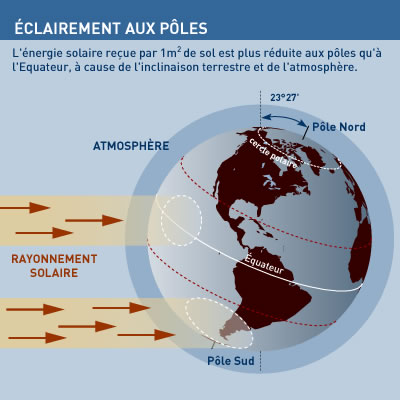
POLAR SUMMER AND WINTER
In the upper latitudes there is no solar radiation in winter. Night lasts for 6 months at the poles, 4 months at 80°N/S and 2 months at 70°N/S. This means it gets very cold: not only is there very little heat input but emissions of infrared heat radiation continue (albeit somewhat reduced by the snow and the pack ice which form an insulating mantle).
In summer, on the other hand, the poles receive solar radiation 24 hours a day, which has a marked warming effect. For a period of about 2 months, around the summer solstice, the number of calories per square metre received each day is actually greater at the poles than at 40°N/S. The effect of this is accentuated by other factors (orientation, etc.), so that temperatures are sometimes quite high during a short period of the year. However, the sun stays quite low in the sky, thus reducing radiation (150 W/m2) and the snow and ice reflect up to 80% of it (albedo effect). So the amount of energy reflected back by the Earth into space is always quite large at the poles, even in summer. Because of this, the ice caps always remain and the ice pack melts quite late in the season.
THE SUN’S ENERGY REFLECTED BACK BY THE EARTH
| Cold fresh snow | up to 90-98% |
| Melting snow | 50-60% |
| Slush (dirty) | 40% |
| Glacier | 50% |
| Ocean | 5-15% |
| Sea ice | 50-85% |
| Desert sands | up to 35% |
| Bare rock | 20-25% |
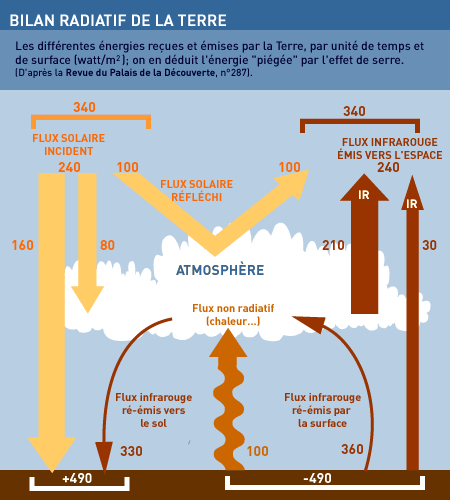
GREENHOUSE EFFECT AND RADIATIVE BALANCE
If the atmosphere were totally transparent to the infrared radiation emitted by the Earth, it would be much colder (on average -18 °C); but the atmosphere (gas, water vapor) absorbs part of this radiation and in turn sends infrared radiation back to the Earth, which thus maintains an average temperature of +15 °C: this is the greenhouse effect.
The temperature at the surface due to this phenomenon corresponds to an ascending IR heat flux of some 390 W/m2; 240 will be lost to space, the atmosphere retaining 150 (greenhouse effect); in addition, 100 W/m2 of non-radiative energy "rising" from the ground (convection...) and 80, absorbed directly from the 240 incident solar energy, are added to the atmosphere. So in the end, 330 W/m2 are "caught" in the atmosphere and radiate towards the ground (downward IR heat flux).
Any increase in the greenhouse effect tends to increase this balance, by decreasing the energy emitted.
SATELLITES AT THE EARTH'S BEDSIDE
Climate is the consequence of the global radiation balance. Knowing this balance with the maximum precision is an essential issue for monitoring climate evolution. Satellites measure the radiation balance at the top of the atmosphere, in watts per square meter. When the global balance is zero, the Earth remains in thermal balance. If this balance becomes positive, the Earth is warming; if it is negative, it is cooling.
All the latest measurements seem to indicate a positive balance.
PHYSICIST’S CORNER
Any body emits a thermal energy W (in joules) equivalent to that of a "black body", which depends only on its absolute temperature T (in Kelvin) according to the law W=sT4, where s is a constant coefficient (Stephan's law). This is the case for the Sun, but also for the Earth, the ocean, the ice, etc.
DID YOU KNOW ?
Our planet intercepts only a very small part (one billionth) of the energy emitted by the Sun. This corresponds to 10,000 times more power (175 million megawatts) than that consumed by humanity! The geothermal flux from the internal heat of our globe is 4,000 times lower (0.09 W/m2).
The sea ice is able to almost totally stop the exchanges between the ocean and the atmosphere. This is called a thermal cover. The tightness of this cover depends on its distribution and thickness. However, it has a certain transparency with respect to solar radiation, which makes possible the partial penetration of visible light into the ocean and the development of marine organisms under the ice.
Support the project with a donation
The Polar POD expedition is one of the stamp of the pioners, a human adventure coupled with a technological challenge, an oceanographic exploration never before carried out which will mark a milestone in the discovery of the oceans.
Thank you for your support !